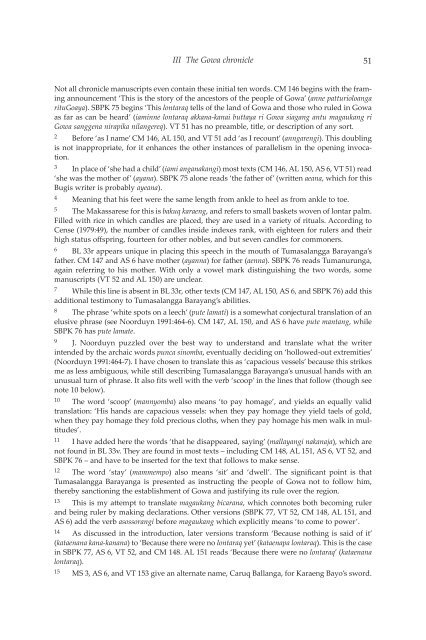A CHAIN OF KINGS - Books and Journals
A CHAIN OF KINGS - Books and Journals
A CHAIN OF KINGS - Books and Journals
Create successful ePaper yourself
Turn your PDF publications into a flip-book with our unique Google optimized e-Paper software.
III The Gowa chronicle 51<br />
Not all chronicle manuscripts even contain these initial ten words. CM 146 begins with the framing<br />
announcement ‘This is the story of the ancestors of the people of Gowa’ (anne patturioloanga<br />
rituGoaya). SBPK 75 begins ‘This lontaraq tells of the l<strong>and</strong> of Gowa <strong>and</strong> those who ruled in Gowa<br />
as far as can be heard’ (iaminne lontaraq akkana-kanai buttaya ri Gowa siagang antu magaukang ri<br />
Gowa sanggena nirapika nilangereq). VT 51 has no preamble, title, or description of any sort.<br />
2 Before ‘as I name’ CM 146, AL 150, <strong>and</strong> VT 51 add ‘as I recount’ (anngarengi). This doubling<br />
is not inappropriate, for it enhances the other instances of parallelism in the opening invocation.<br />
3 In place of ‘she had a child’ (iami anganakangi) most texts (CM 146, AL 150, AS 6, VT 51) read<br />
‘she was the mother of’ (ayana). SBPK 75 alone reads ‘the father of’ (written aeana, which for this<br />
Bugis writer is probably ayeana).<br />
4 Meaning that his feet were the same length from ankle to heel as from ankle to toe.<br />
5 The Makassarese for this is bakuq karaeng, <strong>and</strong> refers to small baskets woven of lontar palm.<br />
Filled with rice in which c<strong>and</strong>les are placed, they are used in a variety of rituals. According to<br />
Cense (1979:49), the number of c<strong>and</strong>les inside indexes rank, with eighteen for rulers <strong>and</strong> their<br />
high status offspring, fourteen for other nobles, <strong>and</strong> but seven c<strong>and</strong>les for commoners.<br />
6 BL 33r appears unique in placing this speech in the mouth of Tumasalangga Barayanga’s<br />
father. CM 147 <strong>and</strong> AS 6 have mother (ayanna) for father (aenna). SBPK 76 reads Tumanurunga,<br />
again referring to his mother. With only a vowel mark distinguishing the two words, some<br />
manuscripts (VT 52 <strong>and</strong> AL 150) are unclear.<br />
7 While this line is absent in BL 33r, other texts (CM 147, AL 150, AS 6, <strong>and</strong> SBPK 76) add this<br />
additional testimony to Tumasalangga Barayang’s abilities.<br />
8 The phrase ‘white spots on a leech’ (pute lamati) is a somewhat conjectural translation of an<br />
elusive phrase (see Noorduyn 1991:464-6). CM 147, AL 150, <strong>and</strong> AS 6 have pute mantang, while<br />
SBPK 76 has pute lamate.<br />
9 J. Noorduyn puzzled over the best way to underst<strong>and</strong> <strong>and</strong> translate what the writer<br />
intended by the archaic words punca sinomba, eventually deciding on ‘hollowed-out extremities’<br />
(Noorduyn 1991:464-7). I have chosen to translate this as ‘capacious vessels’ because this strikes<br />
me as less ambiguous, while still describing Tumasalangga Barayanga’s unusual h<strong>and</strong>s with an<br />
unusual turn of phrase. It also fits well with the verb ‘scoop’ in the lines that follow (though see<br />
note 10 below).<br />
10 The word ‘scoop’ (mannyomba) also means ‘to pay homage’, <strong>and</strong> yields an equally valid<br />
translation: ‘His h<strong>and</strong>s are capacious vessels: when they pay homage they yield taels of gold,<br />
when they pay homage they fold precious cloths, when they pay homage his men walk in multitudes’.<br />
11 I have added here the words ‘that he disappeared, saying’ (mallayangi nakanaja), which are<br />
not found in BL 33v. They are found in most texts ‒ including CM 148, AL 151, AS 6, VT 52, <strong>and</strong><br />
SBPK 76 ‒ <strong>and</strong> have to be inserted for the text that follows to make sense.<br />
12 The word ‘stay’ (mammempo) also means ‘sit’ <strong>and</strong> ‘dwell’. The significant point is that<br />
Tumasalangga Barayanga is presented as instructing the people of Gowa not to follow him,<br />
thereby sanctioning the establishment of Gowa <strong>and</strong> justifying its rule over the region.<br />
13 This is my attempt to translate magaukang bicarana, which connotes both becoming ruler<br />
<strong>and</strong> being ruler by making declarations. Other versions (SBPK 77, VT 52, CM 148, AL 151, <strong>and</strong><br />
AS 6) add the verb asossorangi before magaukang which explicitly means ‘to come to power’.<br />
14 As discussed in the introduction, later versions transform ‘Because nothing is said of it’<br />
(kataenana kana-kanana) to ‘Because there were no lontaraq yet’ (kataenapa lontaraq). This is the case<br />
in SBPK 77, AS 6, VT 52, <strong>and</strong> CM 148. AL 151 reads ‘Because there were no lontaraq’ (kataenana<br />
lontaraq).<br />
15 MS 3, AS 6, <strong>and</strong> VT 153 give an alternate name, Caruq Ballanga, for Karaeng Bayo’s sword.









![Am HaSefer [Volk des Buches] - Books and Journals](https://img.yumpu.com/20648352/1/174x260/am-hasefer-volk-des-buches-books-and-journals.jpg?quality=85)







